
Royal Botanic Gardens, Kew, is a non-departmental public body in the United Kingdom sponsored by the Department for Environment, Food and Rural Affairs. An internationally important botanical research and education institution, it employs 1,100 staff. Its board of trustees is chaired by Dame Amelia Fawcett.
Index Fungorum is an international project to index all formal names in the fungus kingdom. As of 2015 the project is based at the Royal Botanic Gardens, Kew, one of three partners along with Landcare Research and the Institute of Microbiology, Chinese Academy of Sciences.

Micropera, commonly known as dismal orchids or 小囊兰属 is a genus of about twenty species of flowering plants from the orchid family, Orchidaceae. Plants in this genus are large epiphytes with thick roots, long, fibrous stems, linear leaves and whitish or yellow, non-resupinate flowers. The sepals and petals are similar to each other and the labellum is shoe-shaped or sac-like and has three lobes. It is found from Tibet to tropical Asia and the western Pacific Ocean.
The Plant List is a list of botanical names of species of plants created by the Royal Botanic Gardens, Kew and the Missouri Botanical Garden and launched in 2010. It was intended to be a comprehensive record of all known names of plant species over time, and was produced in response to Target 1 of the 2002-2010 Global Strategy for Plant Conservation, to produce "An online flora of all known plants.” It has not been updated since 2013, and is superseded by World Flora Online.

Dendrobium philippinense is a species of orchid in the genus Dendrobium that is native to the Philippines, for which it is named, and also to the Island of Guam in the Micronesia.
Dendrobium mindanaense, known as the Mindanao dendrobium, is an orchid species that is found on the Philippines. It was named for the island of Mindanao.
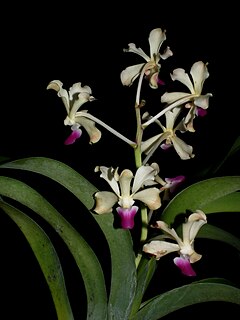
Vanda ustii, the University of Santo Tomas' vanda, is an orchid species found only in the Philippines. It is named after the University of Santo Tomas or U.S.T.
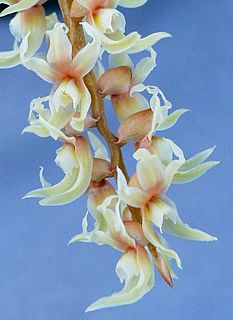
Dendrochilium cootesii is an orchid species found only in the Philippines.
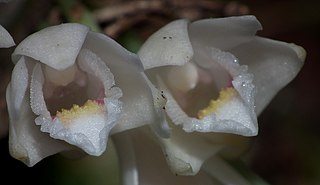
Dendrobium milaniae is flower of the Orchid family found in Leyte, Visayas in the Philippines, where it is found growing as an epiphyte above bodies of water at elevations up to 600 metres. The flower grows to approximately 1.5 centimetres (0.59 in). The plant is semi-pendulous and sympodial. Pseudobulbs are 10 cm by 2 cm; 3 to 6 green lanceolate leaves are present on the top third of the pseudobulb. Hans Fessel and Emil Lückel named this species in 1996 in Die Orchidee.
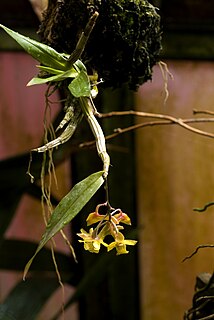
Dendrobium guerreroi, or Guerrero's dendrobium, is a member of the family Orchidaceae endemic to the Philippines. It was named in honor of Mr. Guerrero, a Filipino orchid collector in the 1900s. This species is a small to medium to large sized, warm growing epiphyte with thin descendant, clumping pseudobulbs that rarely branch and carry many, unsubdivided, pointed fleshy leaves. Flowers are 3 centimeters and are yellow with light orange labia.
Cylindrolobus cootesii is plant species of the family Orchidaceae endemic to the Philippines. It is found in the Philippines on the island of Luzon at elevations around 500 meters. It is a small to medium-sized, hot growing epiphyte with an elongated, slightly compressed stem carrying many towards the apical 1/2 to 1/3, distichous, spreading, narrow lanceolate, leathery, basally clasping leaves. It bears flowers on an axillary, .6 to .8" long, single flowered inflorescence. Cylindrolobus cootesii is named after Jim Cootes, an Australian orchid collector.
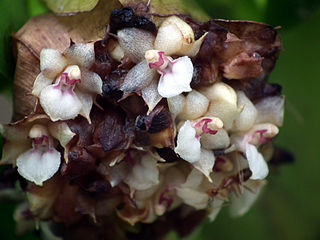
Agrostophyllum philippinense is a species of orchid in the genus Agrostophyllum that was first described by Oakes Ames in 1910. It is endemic to the Philippines.
Aerides inflexa is a species of orchid in the genus Aerides that was first described in 1862. It is native to Borneo and Sulawesi.

Phaius philippinensis is a species of orchid in the genus Phaius that was described by N. E. Brown in 1889. It is endemic to the Philippines.

Phaius fragilis is a species of orchid in the genus Phaius endemic to the Philippines.

Phaius borneensis is a species of orchid in the genus Phaius. It is native to the Islands of Borneo, Palawan and Mindoro.
The World Checklist of Selected Plant Families is an "international collaborative programme that provides the latest peer reviewed and published opinions on the accepted scientific names and synonyms of selected plant families." Maintained by the Royal Botanic Gardens, Kew, it is available online, allowing searches for the names of families, genera and species, as well as the ability to create checklists.

Trichoglottis atropurpurea, the dark purple trichoglottis, is a species of orchid endemic to the Philippines. This hot to warm growing epiphyte was first found growing in mangrove swamps in the islands of Biliran, Catanduanes, Mindanao and Polillo. The plant shares the same appearance with T. philippinensis except for the rich dark color of the blooms and slight variation of the perianth. This species was first described in 1877 by the German botanist Heinrich Gustav Reichenbach, an expert on the orchid family. At that time, thousands of newly discovered orchids were being sent back to Europe, and he was responsible for identifying, describing and classifying many of these new discoveries.
Trichoglottis mindanaensis is a species of epiphytic orchid endemic to the Philippines growing at elevations of 60 to 1,500 meters above sea level. The species was first found on trees overhanging a tidal stream in island of Mindanao in Zamboanga peninsula, hence the specific epithet. The orchid is widely distributed throughout the Philippine archipelago and can also be found in islands of Luzon, Panay and Samar.
Johan Hermans is a British botanist specialising in orchids, and an Honorary Research Associate of Royal Botanic Gardens, Kew. His The Orchids of Madagascar, described as "a now classic work", was published in a second edition in 2007.












